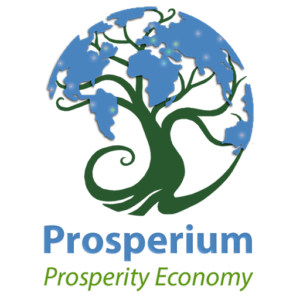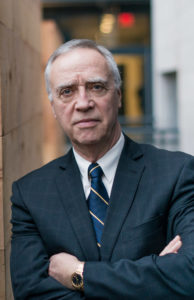
The following is Part 2 of a sponsored Q&A with the founders of the firm behind Canada’s new Prosperium cybercurrency. Doug Coyle, pictured on the left, is the Chief Executive Officer of Toronto-based Prosperium Inc. Tony Humble is President and Chief Organizational Officer. You can find the introductory blog in this series by clicking on Blockchain Revolution, Global Prosperity and Prosperium. Also, a new white paper has just been published.
The pre-Sale rollout plan for Prosperium tokens
Jon Chevreau: Let’s resume with a recap how you’re rolling out Prosperium units and how pricing steps up over time.
Doug Coyle: Our currency Prosperium does have a period at the beginning, which we call our Presale period, when accredited investors can buy the coin at a value that is rising over time. The current value that we’re offering our token at is $2 per token for the presale token. That will be stepped up to $2, $4, $6, $8, $10, $15, $20, then by increments of $10 until finally it gets to $100 per presale token.
That price is based upon the network value; as we accomplish various milestones and increase the value and utility of the Prosperium platform and token the market price increases steadily; but once you reach $100 it then converts at 100 to 1 so one Prosperium token becomes 100 Prosperium “dollars” at a 1 to 1 ratio. It becomes stable at that point. That means that 1 Prosperium dollar is equal to one Canadian dollar. From then on it’s stabilized by smart contracts so it becomes very easy for someone to look at their Smartphone, see their balance is 1000 Prosperium dollars and they know what they what can buy with one thousand Prosperium dollars since it’s equal to C$1,000.
Jon: And outside Canada?
Doug: Each country will have its own Prosperium token that matches the local fiat currency. So in England, one Prosperium pound will equal one UK pound; same with the peso or the US dollar etc. We are set to be a stable-value token in all countries that accept us: wherver the regulators accept our platform so people are able to trade in a currency and know the price of anything in Prosperium dollars or tokens.
This is very different than Bitcoin because right now Bitcoin is worth around $4,000. So on any given day how do know how much the price of a cup of coffee is in Bitcoin? You don’t, not without doing a bit of a calculation or having your phone do it for you. So it’s a big advantage having a stable-value currency for everyday use that you can trust won’t fluctuate and be volatile while they hold it and that they know the price of things in that currency.
Fiat currencies vs cybercurrencies

Jon: You used the term fiat currency just now. Can you comment on traditional “money” and so-called fiat currencies like the dollar, Euro etc.? There’s nothing magical about the value of a dollar except that it’s dictated by governments, right? At least since it’s no longer backed by gold.
Doug: You’re right: part of understanding how to design a currency for Prosperium is understanding the mechanism that all currencies play in an economy; an economy is just a community of people trading their work with each other: goods and services. The economy, the GNP or GDP, is just the sum of all those transactions in that community; so what is money? Money is just a trusted accounting system; and the important word there is trusted. If you’re in an economy or country that has its currency backed by gold or silver or some commodity, you’re using that commodity to create that trust factor; you’re trusting that gold will be relatively stable over time.
If you live in a country like Canada or the United States, or most of the world now, it’s not backed by a commodity like gold or silver but by the promise of the sovereign: of the government. You are relying on the fact that the government will say yes, we’re going to back that dollar and manage it and keep it at a relatively stable value. You can question how much you can trust any sovereign to handle money but that’s the theory. So you have those two systems of creating trust; backed by a commodity or backed by the promise of a sovereign.
Jon: Do you use the term fiat?
Doug: Yes, we use the term fiat. Fiat just means by demand or by order. I as the king demand, or order, that this piece of paper here is worth one Canadian dollar.
What is backing Prosperium?
Jon: At least when it was backed by gold, it was finite, like Bitcoin. But now it’s potentially infinite? Look at Zimbabwe and what happens with inflation when it’s backed by nothing? Or Venezuela.
 Doug: Yes, which raises a very interesting question. What is backing Prosperium? In our case, it’s a very concrete thing that backs it. New currency can be created; you have to remember that all currency is created. There is no such thing as never printing money: you need a certain amount of money, the question is how much money should be out there in circulation in an economy? So when new money is needed in the Prosperium economy, it is printed or created cryptographically. It’s an encryption, it’s mathematics that allows you to trust. That was the third mechanism for creating trust. Bitcoin, the trust that that token holds and that it’s owned by the person who owns its address or its location; that is done through mathematics/cryptography and it’s proven to be an extremely reliable way of keeping track of ownership and of controlling how much of a currency is created; so with Prosperium there’s always going to be a need as the economy grows or as there is unutilized capacity for production; the only way to stimulate or to produce new production is to put new income which requires new money, new circulation, injecting new income into the economy.
Doug: Yes, which raises a very interesting question. What is backing Prosperium? In our case, it’s a very concrete thing that backs it. New currency can be created; you have to remember that all currency is created. There is no such thing as never printing money: you need a certain amount of money, the question is how much money should be out there in circulation in an economy? So when new money is needed in the Prosperium economy, it is printed or created cryptographically. It’s an encryption, it’s mathematics that allows you to trust. That was the third mechanism for creating trust. Bitcoin, the trust that that token holds and that it’s owned by the person who owns its address or its location; that is done through mathematics/cryptography and it’s proven to be an extremely reliable way of keeping track of ownership and of controlling how much of a currency is created; so with Prosperium there’s always going to be a need as the economy grows or as there is unutilized capacity for production; the only way to stimulate or to produce new production is to put new income which requires new money, new circulation, injecting new income into the economy.
Prosperium has a mechanism to do that: our Prosperium accelerators at the local level are very granular in the economy. Whenever you want to put people to work, raise the level to full employment and full production, which is the goal, so all your practical capacity is at practical limits in that economy, that gives you a mechanism … that is the condition under which new money or new income can be created.
Creating prosperity at the local level

Tony Humble: To put things in perspective, the principal way money is created now is either by transfer payments and government projects or by banks leveraging their deposit base. There are many examples of situations where a bank changes its policy, particularly with respect to businesses, for example. A certain type of business may go out of favor or suffer sectoral problems; the bank — and they tend to act somewhat in concert in this regard — can just decide they no longer want to lend to muffler shops; which was doing perfectly good business and had a line of credit of $100,000 but the bank can all of a sudden call their line of credit and put it out of business.
I’ve seen this many times, both as a businessman and a banker. Another situation on the retail level might be someone who wants to get work done: they desperately want to finish their basement but it’s going to cost $25,000. They’re self employed and have good value in their home but they can’t get a line of credit at a decent interest rate because they can’t prove their income; it’s much harder now to get a line of credit than it used to be, for those reasons. So you go to the bank and they say you don’t qualify and the guy sits at home with an unfinished basement for another two or three years. That’s $25,000 worth of economic activity that has been effectively prevented by the bank’s lending policies: that’s the kind of thing we are going to enable, with the muffler shops or any other new business or existing business that wants to grow.
Our bias will be towards sustainable, “green” business. We can enable that by simply providing the means of exchange to enable that economic activity to take place, without depending on whether or not someone in the bank head office decides a particular loan is deserved. And it’s all backstopped with ample reserves.
Doug: That sums up how it is with fiat currencies. The other interesting question here is if you’re creating new money what is the limit? Just how much new money can you inject into a community? And the answer in a Prosperium economy is you can inject new money as long as there is underutilized or unused productive capacity: that can be factories or means of production; it can be people and skilled workers.
Tony: Unutilized productive capacity is only one part of the equation; there also has to be demand for it.

Doug: That’s an important point and is what I’m saying: you can’t create that demand; you’re creating the demand when you create the income. There has to be something the marketplace wants and makes income on but that’s true about putting money into any venture: it has to be market dictated as to what gets produced.
Next time: We look at the chicken-and-egg dilemma of getting a new currency off the ground, stabilizing it with reserve accounts, the currency’s role in asset allocation, and the capital gains treatment and other tax issues involved as a cybercurrency rises in value.

